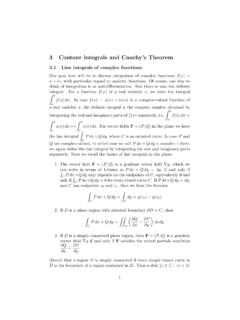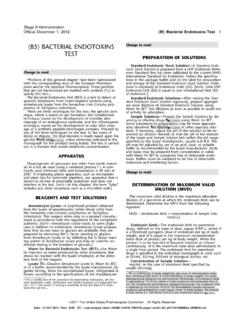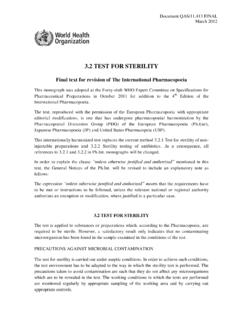Transcription of Strategy for Testing Series: Solutions
1 Strategy for Testing series : ( 5) n= ( 1/5)n, this is a geometric series . Because| 1/5|<1, it < n2+ 6n=n(n+ 6) for alln 0, we have1n(n+ 6)< 1/n2converges (it s ap- series withp= 2>1), the comparison testimplies that 1/(n(n+ 6)) also , the sequencean= 1/(50n) is decreasing and converges to 0. Thus, thealternating series test implies that ( 1)n+ l H opital s rule, we havelimn nlnn= limn 12 n1n= limn n2= .Hence, the limn ( 1)n nlnndoesn t exist and therefore the series ( 1)n+1 the ratio test, we havelimn rn+1(n+1)rrnnr= limn rnr(n+ 1)r= limn r(nn+ 1)r=r <1,and therefore the series (n) = (n2 n) 1/2, thenf (n) = 12(n2 n) 3/2(2n 1). Thus, whenn >1,f (n)<0 andf(n) is decreasing. Moreover, we havelimn f(n) = limn 1 n(n 1)= , the alternating series test implies 1/ n(n 1) < n3+ 2, we have nln(n)n3+ 2< nln(n) , because ln(n)< nfor alln >01, we obtain nln(n)n3+ 2< nnn3=n 3 , the series n 3/2converges (it s ap- series withp= 3/2>1) and hence thecomparison test implies that the series nln(n)n3+2also (x) =lnxx, thenf (x) =1 lnxx2.
2 It follows thatf(x) has a unique critcal point atx=e. Sincef (x)>0 whenx < eandf (x)<0 whenx > e, the first derivative test implies thatf(x) has a globalmaximum ate. Hence,lnxx=f(x) f(e) =lnee<1 which yields lnx < xfor allx > 1 of 7 MAT V1102 004 Solutions : page 2 of a strictly increasing function,e1/n efor alln 1. Hence, we havee1/nn3/2 en3 en 3/2converges (it s ap- series withp= 3/2>1), the comparison testimplies that e1/nn 3/2also (n) =(n+2)(n+3)(n+1)3thenf (n) =(2n+ 5)(n+ 1)3 3(n2+ 5n+ 6)(n+ 1)2(n+ 1)6= n2+ 8n+ 13(n+ 1) 0,f (n)<0 andf(n) is decreasing. Moreover,limn f(n) = limn (n+ 1)(n+ 2)(n+ 1)3= limn n2n3= , the alternating series test implies ( 1)n(n+1)(n+2)(n+1) !=(nn)(nn 1) (nn 2) (n2) (n1)>1,the limit limn ( 1)nnnn!is not zero and hence the series ( 1)nnnn! alln >2, we haven!nn=(nn)(n 1n) (n 2n) (2n) (1n)<(2n) (1n)= 2n 2converges (it s ap- series withp= 2>1), the comparison test impliesthat n!nnconverges. Finally, the absolute convergence test impliesthat the series ( 1)nn!
3 Nnalso the ratio test, we havelimn en+1(n+1)!enn!= limn en+ 1= 0<1,and hence the series enn! the ratio test, we havelimn (n+1)2(n+1)!(2n+2)!n2n!(2n)!= limn (n+ 1)2(n+ 1)(2n+ 2)(2n+ 1)n2= limn n3n4= 0<1,and therefore the series n2n!(2n)! : page 3 of 7 MAT V1102 !< n! + 2, we have3nn! + 2<3nn!.Now, applying the ratio test to the series 3nn!, we obtainlimn 3n+1(n+1)!3nn!= limn 3n+ 1= 0<1, .Thus, the series 3nn!converges and the comparison test implies that 3nn!+ the ratio test, we havelimn n+1(ln(n+1))n+1n(lnn)n= limn n+ 1nln(n+ 1) (lnnln(n+ 1)) lnxis a strictly increasing function, lnn <ln(n+ 1) andlnnln(n+1)<1. Hence,0 limn n+ 1nln(n+ 1) (lnnln(n+ 1))n limn n+ 1nln(n+ 1)= limn 1ln(n+ 1) +nn+1= , limn n+1nln(n+1) (lnnln(n+1))n= 0<1 and the series n(lnn) the ratio test, we havelimn (n+1)65n+1(n+2)!n65n(n+1)!= limn 5(n+ 1)6n6(n+ 2)= limn 5n6n7= 0<1,and hence the series n65n(n+1)! the ratio test, we havelimn en+1(ln(n+1))n+1en(lnn)n= limn eln(n+ 1)(lnnln(n+ 1)) lnxis a strictly increasing function, lnn <ln(n+ 1) and thuslnnln(n+1)< follows that0 limn eln(n+ 1)(lnnlnn+ 1)n limn eln(n+ 1)= , limn eln(n+1)(lnnlnn+1)n= 0<1 and the series en(lnn) |sin(n /7)| 1, we have sin(n /7)n3 V1102 004 Solutions : page 4 of 7 Because the series n 3converges (it s ap- series andp= 3>1), the comparisontest implies that the series sin(n /7)n3 converges.
4 Finally, the absolute convergencetest implies sin(n /7) the ratio test, we havelimn ( 2)n+1(n+1)! ( 2)nn! = limn 2n+ 1= 0<1,and therefore the series ( 2)nn! all positive integersn, we have(1 +1n)n follows that limn ( 1)n(1 +1n)n6= 0 and hence the series ( 1)n(1 +1n) the ratio test, we havelimn ( 1)n+1(2n+3)! ( 1)n(2n+1)! = limn (2n+ 1)!(2n+ 3)!= limn 1(2n+ 3)(2n+ 2)= 0< , the series ( 1)n(2n+1)! L H opital s rule, we havelimn lnnln(lnn)= limn 1n1nlnn= limn lnn= .Therefore, the series lnnln(lnn) xis a strictly increasing function, the inequalityn3< n(n+ 1)(n+ 2) impliesn3/2< n(n+ 1)(n+ 2) and0<1 n(n+ 1)(n+ 2)< n 3 n 3/2converges (it s ap- series withp= 3/2>1), the comparison testimplies that the series 1 n(n+1)(n+2)also 2, the functionf(n) =12n2 1 is positive;f (n) =nis positive andf(2) = both sides of the inequality 0<12n2 1 yields12n2< n2 1 forn the square root function is strictly increasing, we have1 2n < n2 1 and1n n2 1<1 2n2 Solutions : page 5 of 7 MAT V1102 004forn 3.
5 Since 1 2n2converges (it s ap- series withp= 2>1), the comparisontest implies that 1n n2 1also L H opital s rule, we havelimn 3 n+ 1 n+ 1= limn 32 n+112 n= 3 limn nn+ 1= 36= , limn ( 1)n+13 n+1 n+16= 0 which implies that the series ( 1)n+13 n+1 n+ (n) = ln(1 + 1/n) thenf (n) =(11 +1n) ( 1n2)= (1n2+n).Whenn >0,f (n)<0 and thereforef(n) is decreasing. Moreover,limn ln(1 +1n)= ln 1 = 0,and hence the alternating series test implies ( 1)nln(1 +1n) a positive integer then cos(n ) = ( 1)n. Clearly1n+ 1<1nand limn 1n= , the alternating series test implies that the series cosn 3, the functionf(n) =12n3 5 is positive;f (n) =32n2is positive andf(3) =272 5>0. Adding12n3to both sides of the inequality 0<12n3 5 yields12n3< n3 5 which implies1n3 5<2n3forn 3. Since 2n 3converges (it s ap- series withp= 3>1), the comparisontest implies that 1n3 5also (n) = (n2+ 2n+ 1) 1= (n+ 1) 2thenf (n) = 2(n+ 1) 3. Whenn >0,f (n)<0 andf(n) is decreasing. Moreover,limn 1n2+ 2n+ 1= 0,and therefore the alternating series test implies ( 1)n 1n2+2n+ alln 1, we have(2n)!
6 2n n! n=(2n) (2n 1) (n+ 1)2nn=(2n2n) (2n 12) (n+ 12) limn ( 1)n(2n)!2n n! n6= 0 and the series ( 1)n(2n)!2n n! V1102 004 Solutions : page 6 of 5n<5n+n, we have1n+ 5n<15nwhich implies2n+1n+ 5n<2n+15n= 2(25) 2/5<1 the geometric series 2(25)nconverges. Applying the comparisontest, we conclude that 2n+1n+5nalso converges. Finally,|( 2)n+1|= 2n+1so theabsolute convergence test implies that the series ( 2)n+1n+ |sinn|<1, we have ( 1)nsinnn2 the series n 2converges (it s ap- series withp= 2>1), the comparison testimplies that the series sinnn2also converges. Finally, the absolute convergence testimplies that ( 1) < en+ 1, we have2en+ 1< the series 2 e nconverges (it s a geometric series ande 1<1), the compar-ison test implies that the series 2en+1also nsin(1n)= limn sin(1n)1n= limn ( 1n2)cos(1n) 1n2= limn cos(1n)= cos 0 = 16= 0,the series nsin(1n) (x) =1x(lnx)pis positive, continuous and decreasing on [2, ), we may applythe integral test.]
7 Sincep >1, we have 21x(lnx)pdx= limb [11 p(lnn)1 p]b0=1p 1(ln 2)1 p+ limb 11 p(lnb)1 p=1(p 1)(ln 2)p 1,and therefore the series 1n(lnn) (n) = ( n+ n+ 1) 1thenf (n) = ( n+ n+ 1) 2(12 n+12 n+ 1). Solutions : page 7 of 7 MAT V1102 004 Whenn >0,f (n)<0 andf(n) is decreasing. Moreover,limn 1 n+ n+ 1= 0,so the alternating series test implies ( 1)n n+ n+1converges.













